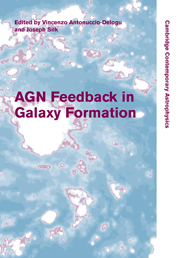Book contents
- Frontmatter
- Contents
- List of contributors
- Preface
- The organising committees
- Part I AGNs, starbursts and galaxy evolution
- Part II Co-evolution of black holes and galaxies
- Part III Outflows and radio galaxies
- 8 Interaction and gas outflows in radio-loud AGN: disruptive and constructive effects of radio jets
- 9 Young radio sources: evolution and broad-band emission
- 10 The duty cycle of radio galaxies and AGN feedback
- 11 Environment or outflows? New insight into the origin of narrow associated QSO absorbers
- Part IV Models and numerical simulations: methods and results
- Index
11 - Environment or outflows? New insight into the origin of narrow associated QSO absorbers
from Part III - Outflows and radio galaxies
Published online by Cambridge University Press: 10 November 2010
- Frontmatter
- Contents
- List of contributors
- Preface
- The organising committees
- Part I AGNs, starbursts and galaxy evolution
- Part II Co-evolution of black holes and galaxies
- Part III Outflows and radio galaxies
- 8 Interaction and gas outflows in radio-loud AGN: disruptive and constructive effects of radio jets
- 9 Young radio sources: evolution and broad-band emission
- 10 The duty cycle of radio galaxies and AGN feedback
- 11 Environment or outflows? New insight into the origin of narrow associated QSO absorbers
- Part IV Models and numerical simulations: methods and results
- Index
Summary
Introduction
AGN feedback is widely proposed as the solution to a number of otherwise difficult-to-explain problems in extra-galactic astrophysics. From an observational perspective, it is worth first dissecting the forms of ‘feedback’ that are under discussion, before embarking on any project to observe this potentially universal process. Figure 11.1 gives a short summary of the topic of feedback, which can broadly be split into two parts (column 2): heating of gas in situ, and outflows that remove matter from the host galaxy. Both processes may, or may not, be associated with jets, so jets have been placed separately. While outflows are assumed to predominantly affect the nuclear region and possibly the ISM of the host galaxy, in-situ heating of the gas must occur on very large scales within the IGM (column 3). The final column presents a selection of observed or yet-to-be-observed consequences of the physical mechanisms: the list is not meant to be exhaustive, but simply presents the range of the observations with which we must deal. While there is little argument that some aspects of AGN feedback have been directly detected, conclusive evidence for routine quenching of star formation and removal of the interstellar medium of the QSO host galaxy remains elusive.
Of particular relevance to this contribution are the narrow absorption line systems (NALs), which appear in every box on the right-hand side of Figure 11.1, and are arguably one of the best candidates for directly detecting ‘ubiquitous’ QSO feedback.
- Type
- Chapter
- Information
- AGN Feedback in Galaxy Formation , pp. 98 - 108Publisher: Cambridge University PressPrint publication year: 2010

